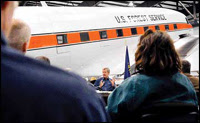 Last year wilderness rangers in the Inyo National Forest in California began receiving reports from hikers about a red stain near the 13,200′ Feather Peak in the John Muir Wilderness. It turned out to be retardant apparently dropped by an air tanker. This was very odd, since there had been no fire in the area.
Last year wilderness rangers in the Inyo National Forest in California began receiving reports from hikers about a red stain near the 13,200′ Feather Peak in the John Muir Wilderness. It turned out to be retardant apparently dropped by an air tanker. This was very odd, since there had been no fire in the area.
Further investigation uncovered the fact that it was dropped July 8, 2007 by the crew of Tanker 55, a P2V launched from Porterville, California. The flight crew initially said that the aircraft developed engine trouble and they jettisoned the 17,500 pounds of retardant for safety reasons. This is standard procedure during some types of in-flight emergencies–a lighter load makes it easier to fly a crippled airplane. The crew, however, did not report the engine problem, or request any repairs upon landing.
Because some aspects of the crew’s story did not add up, US Forest Service Law Enforcement investigators got involved. There are indications now that there was no engine trouble, but the air crew had to dump the load somewhere, since they could not land with a full tank of retardant. Rather than drop it in the designated areas for retardant dumping, they, for some reason, chose to drop it near a peak in a wilderness area… a rocky peak with little vegetation. At 13,200′, the red retardant will likely be visible for years before it degrades.



